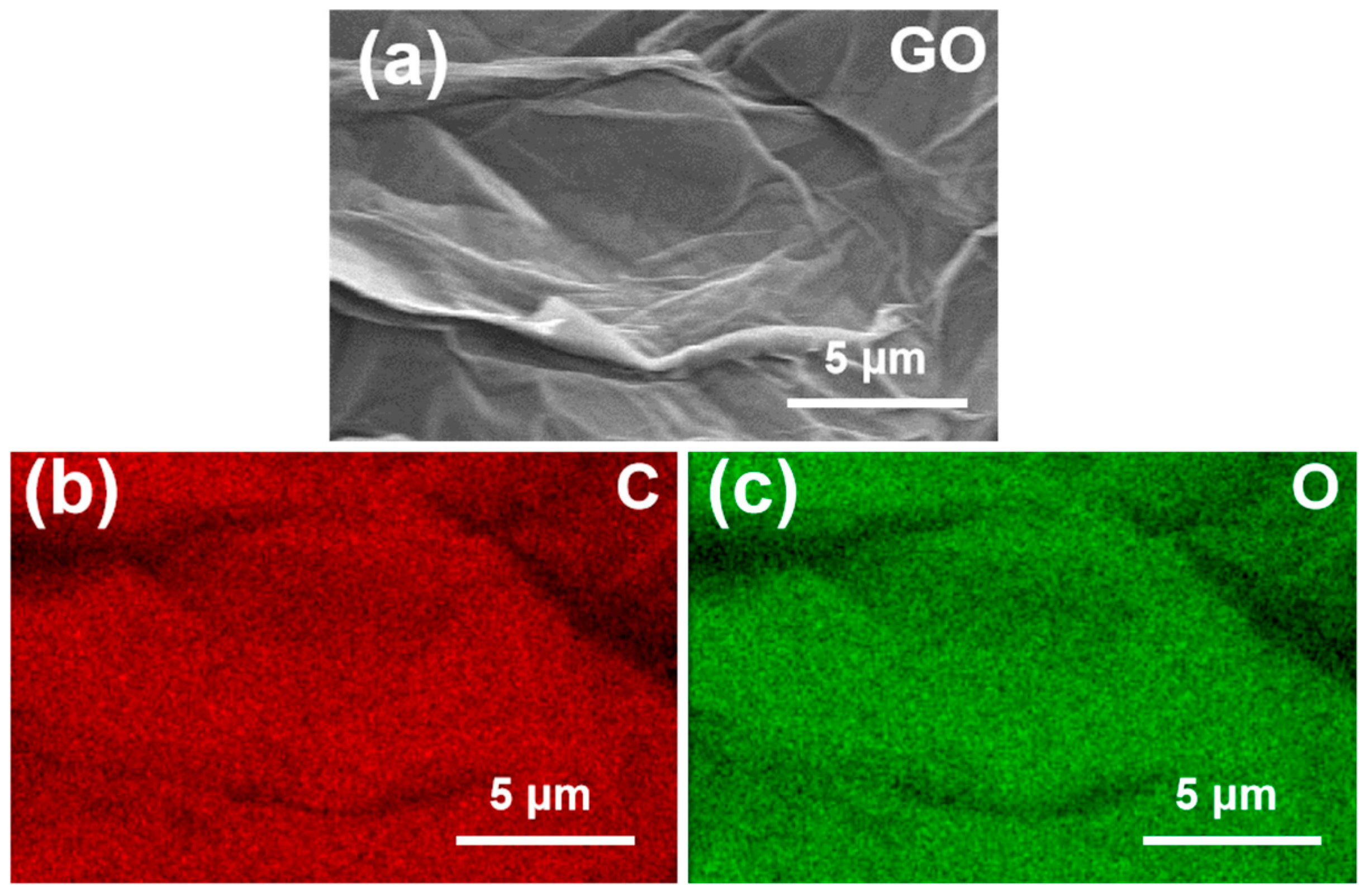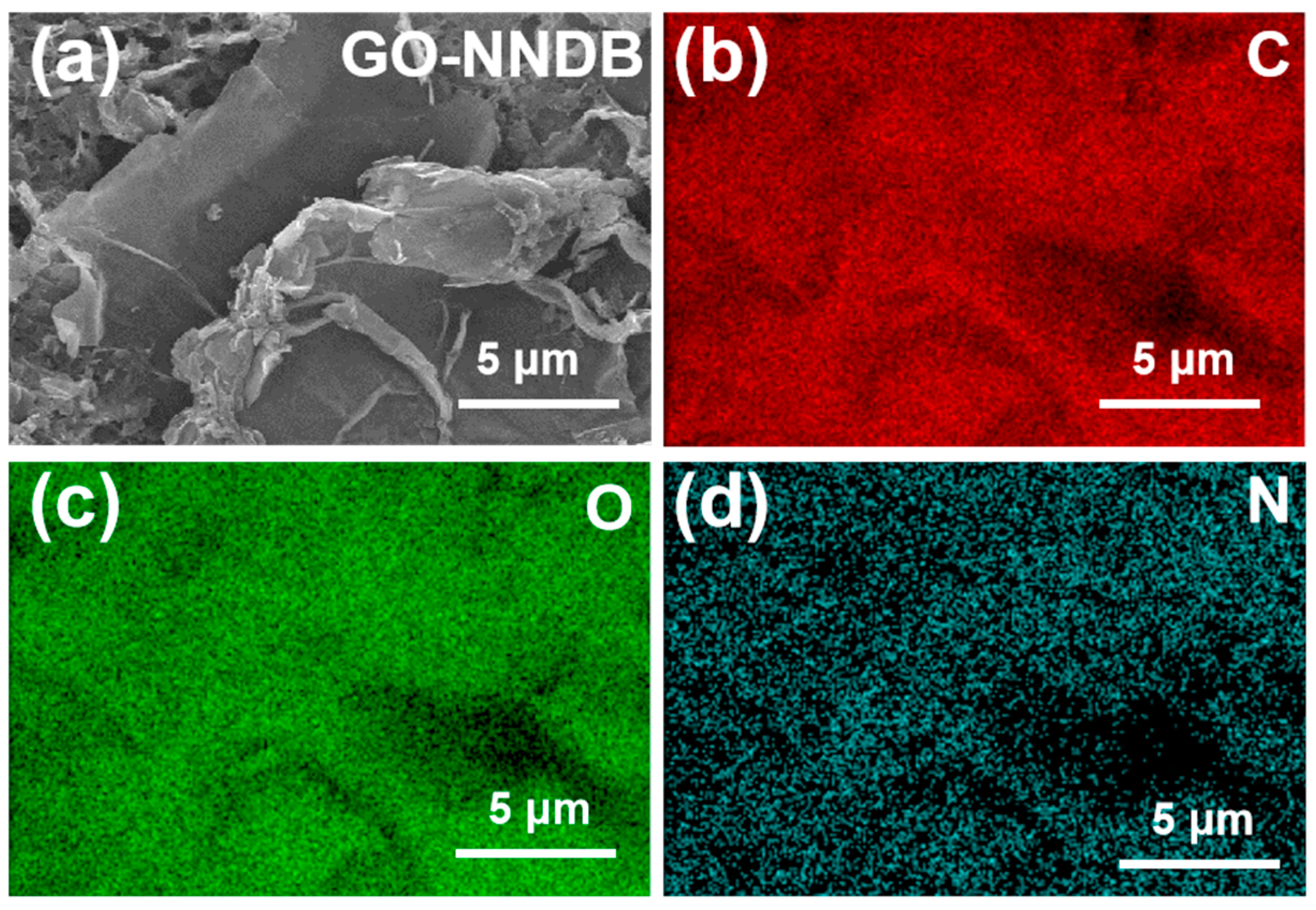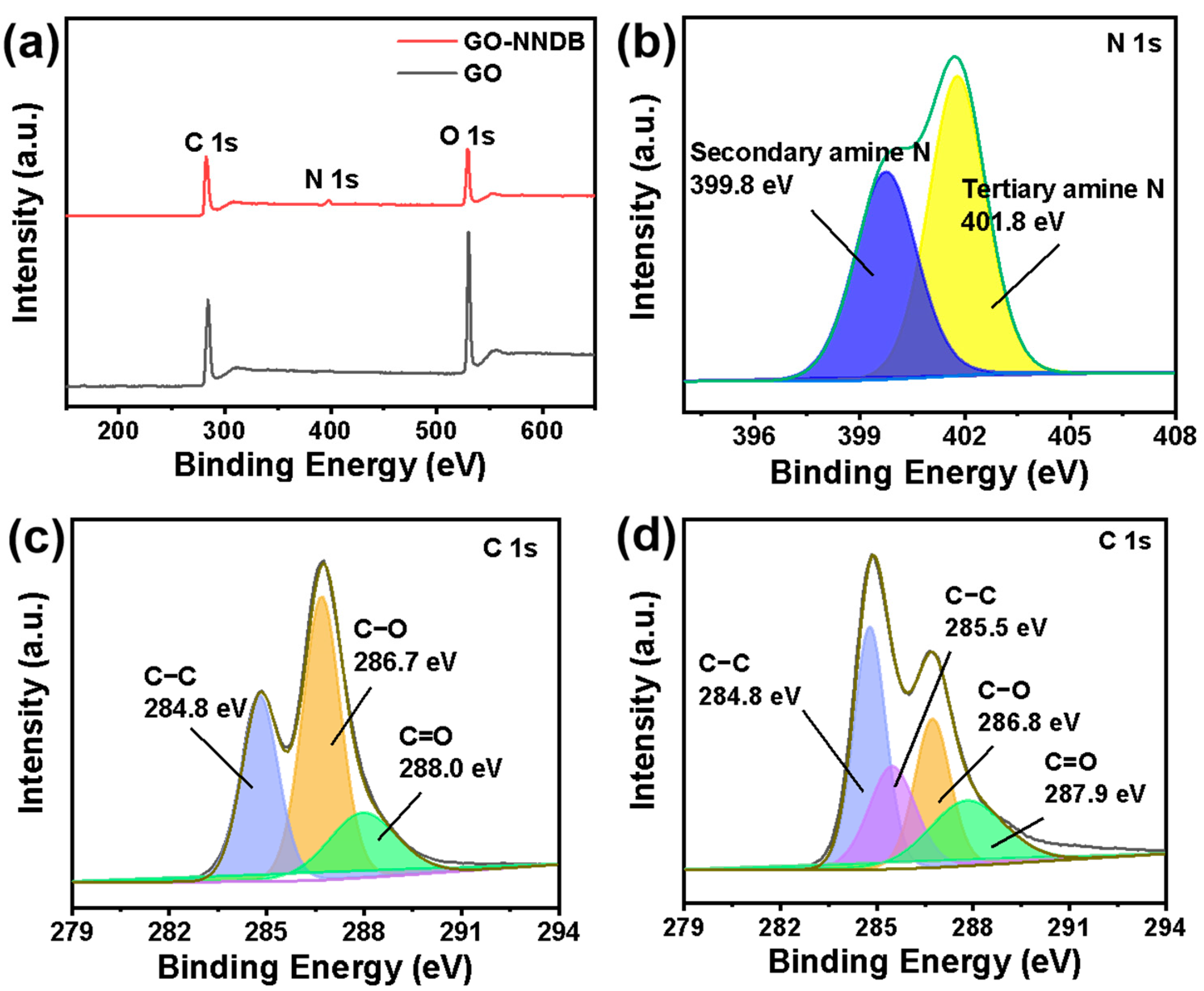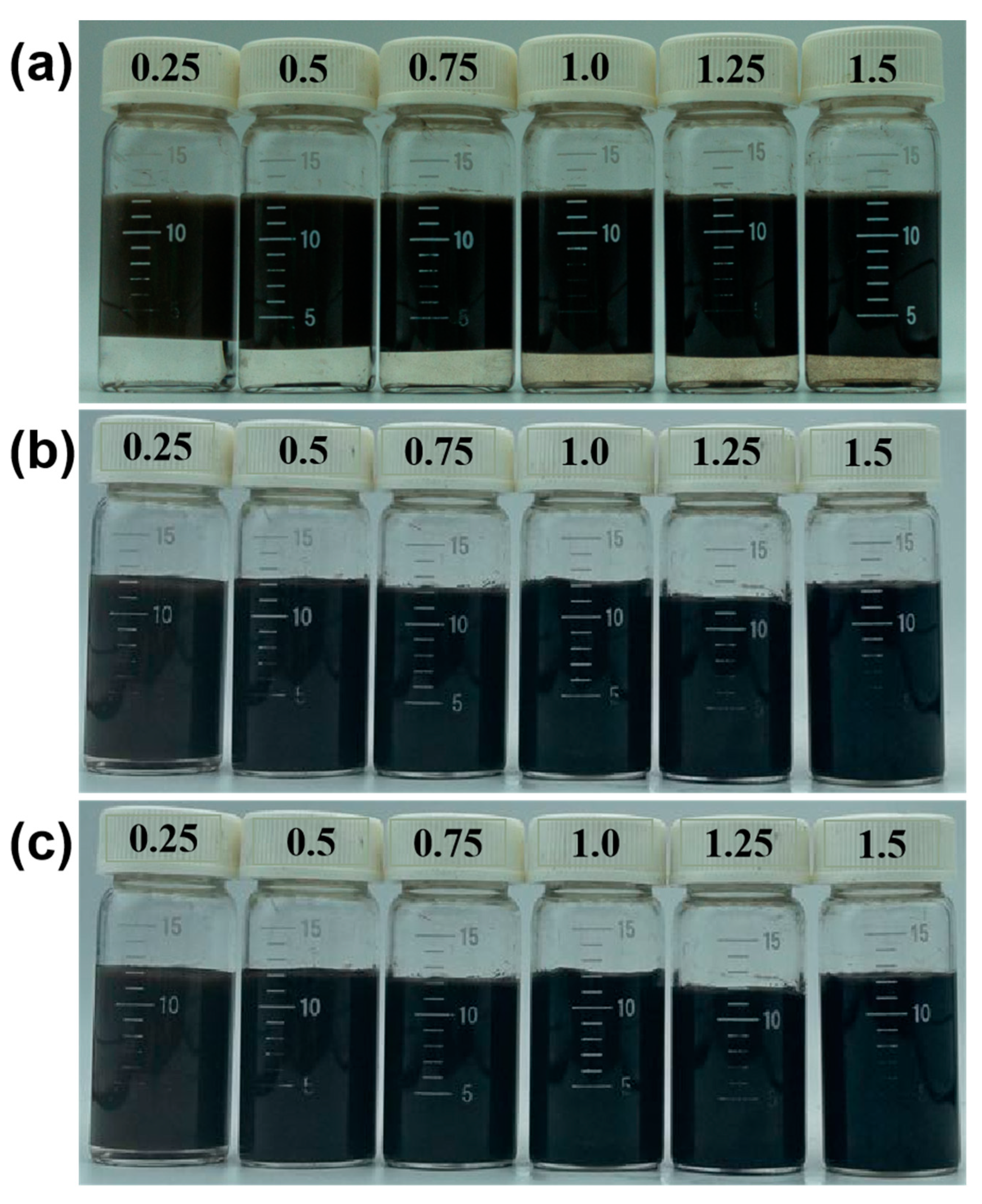Preparation and Emulsifying Properties of Carbon-Based Pickering Emulsifier
Abstract
:1. Introduction
2. Materials and Methods
2.1. Material and Reagent
2.2. Preparation of Materials and Emulsions
2.2.1. Preparation of GO
2.2.2. Preparation of GO-NNDB
2.2.3. Preparation of Pickering Emulsion
2.3. Emulsion Stability Test
2.3.1. Thermal Stability Test
2.3.2. Stability Test
2.4. Determination of Emulsion Type
2.5. Materials Characterization
3. Results and Discussion
3.1. Characterization of Emulsifiers
3.1.1. SEM/EDS
3.1.2. FT-IR
3.1.3. XPS
3.2. Emulsion Effect Optimization
3.3. Emulsion Stability
4. Conclusions
Author Contributions
Funding
Data Availability Statement
Conflicts of Interest
References
- Ramsden, W. Separation of Solids in the Surface-Layers of Solutions and ‘Suspensions’ (Observations on Surface-Membranes, Bubbles, Emulsions, and Mechanical Coagulation)—Preliminary Account. Proc. R. Soc. London 1903, 72, 156–164. [Google Scholar]
- Pickering, S.U. Cxcvi. J. Chem. Soc. Trans. 1907, 91, 2001–2021. [Google Scholar] [CrossRef] [Green Version]
- Bizmark, N.; Ioannidis, M.A. Ethyl cellulose nanoparticles at the alkane–water interface and the making of Pickering emulsions. Langmuir. 2017, 33, 10568–10576. [Google Scholar] [CrossRef] [PubMed]
- Zhang, X.; Wang, D.; Liu, S.; Tang, J. Bacterial Cellulose Nanofibril-Based Pickering Emulsions: Recent Trends and Applications in the Food Industry. Foods 2022, 11, 4064. [Google Scholar] [CrossRef]
- Klojdová, I.; Stathopoulos, C. The potential application of Pickering multiple emulsions in food. Foods 2022, 11, 1558. [Google Scholar] [CrossRef] [PubMed]
- Gricius, Z.; Øye, G. Recent advances in the design and use of Pickering emulsions for wastewater treatment applications. Soft Matter. 2023, 19, 818–840. [Google Scholar] [CrossRef]
- Fu, L.P.; Ma, Q.L.; Liao, K.L.; Bai, J.M. Application of Pickering emulsion in oil drilling and production. Nanotechnol. Rev. 2022, 11, 26–39. [Google Scholar] [CrossRef]
- Tian, Y.; Zhou, J.J.; He, C.Q.; He, L.; Liu, X.G.; Sui, H. The Formation, Stabilization and Separation of Oil–Water Emulsions: A Review. Processes 2022, 10, 738. [Google Scholar] [CrossRef]
- Peito, S.; Peixoto, D.; Ferreira-Faria, I.; Margarida, M.A.; Margarida, R.H.; Francisco, V.; Marto, J. Nano-and microparticle-stabilized Pickering emulsions designed for topical therapeutics and cosmetic applications. Int. J. Pharmaceut. 2022, 615, 121455. [Google Scholar] [CrossRef]
- Lv, G.J.; Wang, F.M.; Zhang, X.B.; Binks, B.P. Surface-active hollow titanosilicate particles as a Pickering interfacial catalyst for liquid-phase alkene epoxidation reactions. Langmuir. 2018, 34, 302–310. [Google Scholar] [CrossRef]
- Clarke, C.J.; Tu, W.C.; Levers, O.; Hallett, J.P.; Brohl, A. Green and sustainable solvents in chemical processes. Chem Rev. 2018, 118, 747–800. [Google Scholar] [CrossRef] [PubMed]
- Chen, S.; Yan, S.; Zou, H.B.; Xue, N.; Yang, H.Q. Janus mesoporous silica nanosheets with perpendicular mesochannels: Affording highly accessible reaction interfaces for enhanced biphasic catalysis. Chem. Commun. 2018, 54, 10455–10458. [Google Scholar]
- Leclercq, L.; Nardello-Rataj, V. Pickering emulsions based on cyclodextrins: A smart solution for antifungal azole derivatives topical delivery. Eur. J. Pharm. Sci. 2016, 82, 126–137. [Google Scholar] [CrossRef]
- Ni, L.; Yu, C.; Wei, Q.B.; Qiu, J.S.; Liu, D.M. Pickering emulsion catalysis: Interfacial chemistry, catalyst design, challenges, and perspectives. Angew. Chem. Int. Edit. 2022, 61, e202115885. [Google Scholar] [CrossRef]
- Wei, Q.B.; Yu, C.; Song, X.D.; Zhong, Y.P.; Ni, L.; Ren, Y.W.; Guo, W.; Yu, J.H.; Qiu, J.S. Recognition of water-induced effects toward enhanced interaction between catalyst and reactant in alcohol oxidation. J. Am. Chem. Soc. 2021, 143, 6071–6078. [Google Scholar] [CrossRef] [PubMed]
- Ding, Y.; Xu, H.; Wu, H.H.; Wu, P.; He, M.Y. An amphiphilic composite material of titanosilicate@ mesosilica/carbon as a Pickering catalyst. Chem. Commun. 2018, 54, 7932–7935. [Google Scholar] [CrossRef] [PubMed]
- Zhang, Y.B.; Ettelaie, R.; Binks, B.P.; Yang, H.Q. Highly selective catalysis at the liquid–liquid interface microregion. Acs. Catal. 2021, 11, 1485–1494. [Google Scholar] [CrossRef]
- Shi, H.; Fan, Z.Y.; Hong, B.; Pera-Titus, M. Aquivion perfluorosulfonic superacid as an efficient pickering interfacial catalyst for the hydrolysis of triglycerides. ChemSusChem 2017, 10, 3363–3367. [Google Scholar] [CrossRef]
- Xi, Y.K.; Liu, B.; Wang, S.X.; Wei, S.H.; Yin, S.W.; Ngai, T.; Yang, H.Q. CO2-responsive Pickering emulsions stabilized by soft protein particles for interfacial biocatalysis. Chem. Sci. 2022, 13, 2884–2890. [Google Scholar] [CrossRef]
- Gaudin, P.; Jacquot, R.; Marion, P.; Pouilloux, Y.; Jérôme, F. Acid-Catalyzed Etherification of Glycerol with Long-Alkyl-Chain Alcohols. ChemSusChem 2011, 4, 719–722. [Google Scholar] [CrossRef]
- Wu, J.; Ma, G.H. Recent studies of Pickering emulsions: Particles make the difference. Small 2016, 12, 4633–4648. [Google Scholar] [CrossRef] [PubMed]
- Björkegren, S.; Nordstierna, L.; Törncrona, A.; Palmqvist, A. Hydrophilic and hydrophobic modifications of colloidal silica particles for Pickering emulsions. J. Colloid. Interf. Sci. 2017, 487, 250–257. [Google Scholar] [CrossRef] [PubMed]
- Hao, Y.J.; Liu, Y.F.; Yang, R.; Jian, L.; Zhang, X.M.; Yang, H.Q. A pH-responsive TiO2-based Pickering emulsion system for in situ catalyst recycling. Chinese Chem. Lett. 2018, 29, 778–782. [Google Scholar] [CrossRef]
- Otero, J.; Meeker, S.; Clegg, P.S. Compositional ripening of particle-stabilized drops in a three-liquid system. Soft Matter 2018, 14, 3783–3790. [Google Scholar] [CrossRef] [PubMed] [Green Version]
- Cuevas-Gómez, A.P.; González-Magallanes, B.; Arroyo-Maya, I.J.; GutiérrezLópez, G.F.; CornejoMazón, M.; Hernández-Sánchez, H. Squalene-Rich Amaranth Oil Pickering Emulsions Stabilized by Native α-Lactalbumin Nanoparticles. Foods 2022, 11, 1998. [Google Scholar] [CrossRef]
- Hu, J.; Xu, R.Y.; Deng, W.J. Dual stabilization of Pickering emulsion with epigallocatechin gallate loaded mesoporous silica nanoparticles. Food Chem. 2022, 396, 133675. [Google Scholar] [CrossRef]
- Nagarajan, S.; Abessolo Ondo, D.; Gassara, S.; Bechelany, M.; Balme, S.; Miele, P.; Kalkura, N.; Pochat-Bohatier, C. Porous gelatin membrane obtained from Pickering emulsions stabilized by graphene oxide. Langmuir 2018, 34, 1542–1549. [Google Scholar] [CrossRef]
- Gonzalez-Ortiz, D.; Pochat-Bohatier, C.; Gassara, S.; Cambedouzou, J.; Bechelany, M.; Miele, P. Development of novel h-BNNS/PVA porous membranes via Pickering emulsion templating. Green Chem. 2018, 20, 4319–4329. [Google Scholar] [CrossRef]
- Ortiz, D.G.; Pochat-Bohatier, C.; Cambedouzou, J.; Bechelany, M.; Miele, P. Pickering emulsions stabilized with two-dimensional (2D) materials: A comparative study. Colloid Surf. A 2019, 563, 183–192. [Google Scholar] [CrossRef]
- Yang, T.Y.; Wei, L.J.; Jing, L.Y.; Liang, J.F.; Zhang, X.M.; Tang, M.; Monteiro, M.J.; Chen, Y.; Wang, Y.; Gu, S.; et al. Dumbbell-shaped bi-component mesoporous Janus solid nanoparticles for biphasic interface catalysis. Angew. Chem. Int. Edit. 2017, 56, 8459–8463. [Google Scholar] [CrossRef] [Green Version]
- Hou, H.H.; Li, J.; Li, X.M.; Forth, J.; Yin, J.; Jiang, X.S.; Helms, B.A.; Russell, T.P. Interfacial Activity of Amine-Functionalized Polyhedral Oligomeric Silsesquioxanes (POSS): A Simple Strategy to Structure Liquids. Angew. Chem. 2019, 131, 10248–10253. [Google Scholar] [CrossRef]
- Xie, D.H.; Jiang, Y.L.; Li, K.L.; Yang, X.Y.; Zhang, Y.J. Pickering emulsions stabilized by mesoporous nanoparticles with different morphologies in combination with DTAB. ACS Omega 2022, 7, 29153–29160. [Google Scholar] [CrossRef] [PubMed]
- Kumar, H.; Dugyala, V.R.; Basavaraj, M.G. Phase Inversion of Ellipsoid-Stabilized Emulsions. Langmuir 2021, 37, 7295–7304. [Google Scholar] [CrossRef] [PubMed]
- Li, X.; Li, J.; Gong, J.; Kuang, Y.S.; Mo, L.H.; Song, T. Cellulose nanocrystals (CNCs) with different crystalline allomorph for oil in water Pickering emulsions. Carbohyd. Polym. 2018, 183, 303–310. [Google Scholar] [CrossRef]
- Wu, C.; Hou, D.S.; Yin, B.; Li, S.H. Synthesis and application of new core-shell structure via Pickering emulsion polymerization stabilized by graphene oxide. Compos. Part B-Eng. 2022, 247, 110285. [Google Scholar] [CrossRef]
- Cui, D.H.; Shi, B.F.; Xia, Z.N.; Zhu, W.J.; Lu, C.L. Construction of polymer brush-decorated amphiphilic Janus graphene oxide nanosheets via a Pickering emulsion template for catalytic applications. New J. Chem. 2022, 46, 20855–20865. [Google Scholar] [CrossRef]
- Skorupska, M.; Ilnicka, A.; Lukaszewicz, J.P. Successful Manufacturing Protocols of N-Rich Carbon Electrodes Ensuring High ORR Activity: A Review. Processes 2022, 10, 643. [Google Scholar] [CrossRef]
- Liu, R.; Xu, Y.X.; Pu, W.F.; Shi, P.; Du, D.J.; James, J.S.; Yong, H.S. Oligomeric ethylene-glycol brush functionalized graphene oxide with exceptional interfacial properties for versatile applications. Appl. Surf. Sci. 2022, 606, 154856. [Google Scholar] [CrossRef]
- Kim, J.; Cote, L.J.; Kim, F.; Yuan, W.; Shull, K.R.; Huang, J.X. Graphene oxide sheets at interfaces. J. Am. Chem. Soc. 2010, 132, 8180–8186. [Google Scholar] [CrossRef]
- Gudarzi, M.M.; Sharif, F. Self assembly of graphene oxide at the liquid-liquid interface: A new route to the fabrication of graphene based composites. Soft Matter. 2011, 7, 3432–3440. [Google Scholar] [CrossRef]
- Tang, J.; Cao, S.X.; Wang, J.L. CO2-switchable Pickering emulsions: Efficient and tunable interfacial catalysis for alcohol oxidation in biphasic systems. Chem. Commun. 2019, 55, 11079–11082. [Google Scholar] [CrossRef] [PubMed]
- Shan, Y.Y.; Yu, C.; Zhang, M.D.; Wei, Q.B.; An, J.L.; Lv, H.H.; Ni, L.; Qiu, J.S. Passivating the pH-Responsive Sites to Configure a Widely pH-Stable Emulsifier for High-Efficiency Benzyl Alcohol Oxidation. ChemSusChem 2022, 15, e202102473. [Google Scholar] [CrossRef] [PubMed]
- He, Y.Q.; Wu, F.; Sun, X.Y.; Li, R.Q.; Guo, Y.Q.; Li, C.B.; Zhang, L.; Xing, F.B.; Wang, W.; Gao, J.P. Factors that affect pickering emulsions stabilized by graphene oxide. Acs. Appl. Mater. Inter. 2013, 5, 4843–4855. [Google Scholar] [CrossRef]
- Ederer, J.; Ecorchard, P.; Slušná, M.Š.; Tolasz, Z.; Smržová, D.; Lupínková, S.; Janoš, P. A Study of Methylene Blue Dye Interaction and Adsorption by Monolayer Graphene Oxide. Adsorpt. Sci. Technol. 2022, 2022, 7385541. [Google Scholar] [CrossRef]
- Wan, W.B.; Li, L.L.; Zhao, Z.B.; Hu, H.; Hao, X.J.; Winkler, D.A.; Xi, L.C.; Hughes, T.C.; Qiu, J.S. Ultrafast fabrication of covalently cross-linked multifunctional graphene oxide monoliths. Adv. Funct. Mater. 2014, 24, 4915–4921. [Google Scholar] [CrossRef]
- Caliman, C.C.; Mesquita, A.F.; Cipriano, D.F.; Freitas, J.C.C.; Cotta, A.A.C.; Macedo, W.A.A.; Porto, A.O. One-pot synthesis of amine-functionalized graphene oxide by microwave-assisted reactions: An outstanding alternative for supporting materials in supercapacitors. Rsc. Adv. 2018, 8, 6136–6145. [Google Scholar] [CrossRef] [Green Version]
- Xue, B.; Zhu, J.G.; Liu, N.; Li, Y.X. Facile functionalization of graphene oxide with ethylenediamine as a solid base catalyst for Knoevenagel condensation reaction. Catal. Commun. 2015, 64, 105–109. [Google Scholar] [CrossRef]
- Binks, B.P.; Lumsdon, S.O. Influence of particle wettability on the type and stability of surfactant-free emulsions. Langmuir 2000, 16, 8622–8631. [Google Scholar] [CrossRef]
- Ou, L.L.; Song, B.; Liang, H.M.; Liu, J.; Feng, X.L.; Deng, B.; Sun, T.; Shao, L.Q. Toxicity of graphene-family nanoparticles: A general review of the origins and mechanisms. Part. Fibre Toxicol. 2016, 13, 57. [Google Scholar] [CrossRef] [Green Version]











Disclaimer/Publisher’s Note: The statements, opinions and data contained in all publications are solely those of the individual author(s) and contributor(s) and not of MDPI and/or the editor(s). MDPI and/or the editor(s) disclaim responsibility for any injury to people or property resulting from any ideas, methods, instructions or products referred to in the content. |
© 2023 by the authors. Licensee MDPI, Basel, Switzerland. This article is an open access article distributed under the terms and conditions of the Creative Commons Attribution (CC BY) license (https://creativecommons.org/licenses/by/4.0/).
Share and Cite
Lv, H.; Wang, Z.; An, J.; Li, Z.; Shi, L.; Shan, Y. Preparation and Emulsifying Properties of Carbon-Based Pickering Emulsifier. Processes 2023, 11, 1070. https://doi.org/10.3390/pr11041070
Lv H, Wang Z, An J, Li Z, Shi L, Shan Y. Preparation and Emulsifying Properties of Carbon-Based Pickering Emulsifier. Processes. 2023; 11(4):1070. https://doi.org/10.3390/pr11041070
Chicago/Turabian StyleLv, Huihui, Zebo Wang, Jialong An, Zhanfeng Li, Lei Shi, and Yuanyuan Shan. 2023. "Preparation and Emulsifying Properties of Carbon-Based Pickering Emulsifier" Processes 11, no. 4: 1070. https://doi.org/10.3390/pr11041070
APA StyleLv, H., Wang, Z., An, J., Li, Z., Shi, L., & Shan, Y. (2023). Preparation and Emulsifying Properties of Carbon-Based Pickering Emulsifier. Processes, 11(4), 1070. https://doi.org/10.3390/pr11041070





